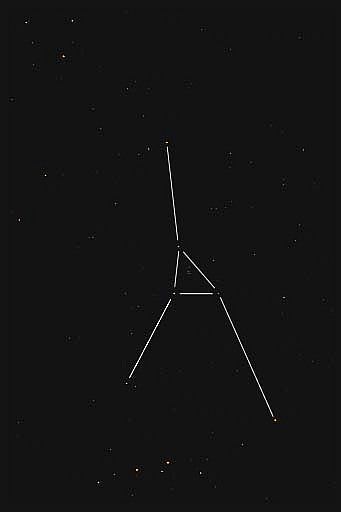|
From the website 1 for
"Star Gazer," a television series shown on the United States' American
Public Broadasting System comes this excerpt from their 994th show,
aired from December 23 to December 29th of 1996. The show's host, Jack
Horkheimer, is quoted as saying this in the transcripts:
...I'd like to
retell a story about a fascinating cosmic coincidence I discovered back
in December of '87, a story many viewers ask me to retell year after
year.
It all happened by accident as I was searching for something unusual
for my Christmas week show and strangely it all began, not with a
constellation of winter, but with a constellation of summer, Cygnus the
swan, a star pattern which rises in the east just after sunset in July.
I think Cygnus has always enchanted me because it looks so much like
its name, a graceful swan, its tail marked by one bright star, its beak
by another, a star for the tip of the left wing and a star for the tip
of the right wing; stars which, if we draw lines between them,
represent a swan with outstretched wings. In my youth I always loved to
watch Cygnus rise in the east on summer evenings and climb higher and
higher until at midnight he appeared with wings outstretched across the
very roof of heaven. Then after midnight he would silently descend,
gliding downward to the western horizon.
Now one thing that always fascinated me about Cygnus was that as he
approached the western horizon he seemed to change his shape from a
swan into a great cross, a star pattern early Christians called the
Northern Cross [Ed. it is still known as such]. It was also interesting
to me that every year during Christmas week, around 8 p.m. or so that
this cross stands almost upright on the northwestern horizon.
And in December of '87 as I was researching my Christmas show the
little obscure star cluster called the "Bee Hive" caught my attention
and jogged an old memory, for I remembered that the Bee Hive's real
name is 'Praesepe' which is Latin for 'The Manger'.
So I said to myself, "Wouldn't it be a nice coincidence if at Christmas
time we could see both the Cross and the Manger at the same time?"
Well, just for fun I picked up my star wheel and dialed in December
25th, 8 p.m. and noticed something which gave me a pleasant start . . .
for indeed, there on the wheel at 8 p.m. on the 25th of December was
not only the Northern Cross standing upright on the western horizon,
just about to set, but directly opposite on the eastern horizon was
Praesepe, the Manger, just rising.
And they will always be there opposite each other in the heavens every
year, every Christmas of our lives. How poetic. Indeed, in all my years
as a star gazer I had never heard or read of this lovely coincidence.
So, as you gaze up at the night sky this Christmas week at the setting
Cross and the rising Manger, may the heavens themselves remind you of a
wish that should know no religious boundaries and that is simply: Peace
On Earth, Good Will Toward Men . . . a hope for all mankind of all
beliefs if we remind each other to Keep Looking Up!
Never minding
the
(typical) misquoting of the verse that should read "peace on earth to
men of good will," this is a beautiful thing.
Praesepe (Messier: M44) is a star cluster right in the center of the
not-so-very-bright constellation of Cancer, and to the naked eye, it
looks like a nebula. The two nearby bright stars, gamma and delta CAN
(or 4 and 5 CAN), are, quite interestingly, called "The Asses." To find
Praesepe, look toward the East. Follow an imaginary line from Spica
Virginis under Regulus in Leo, and about 22° beyond it will touch
Praesepe. Praesepe, by the way, was often used to predict the weather:
if it was very hard to see, then rain is said to be imminent.

Cygnus, the "Northern Cross," is best seen in the summer sky,
but as the astronomer above noted, it will appear especially
Cross-shaped on the Western horizon today...

Footnote:
1
http://www.starhustler.com/scripts_dec96.html
|
|

